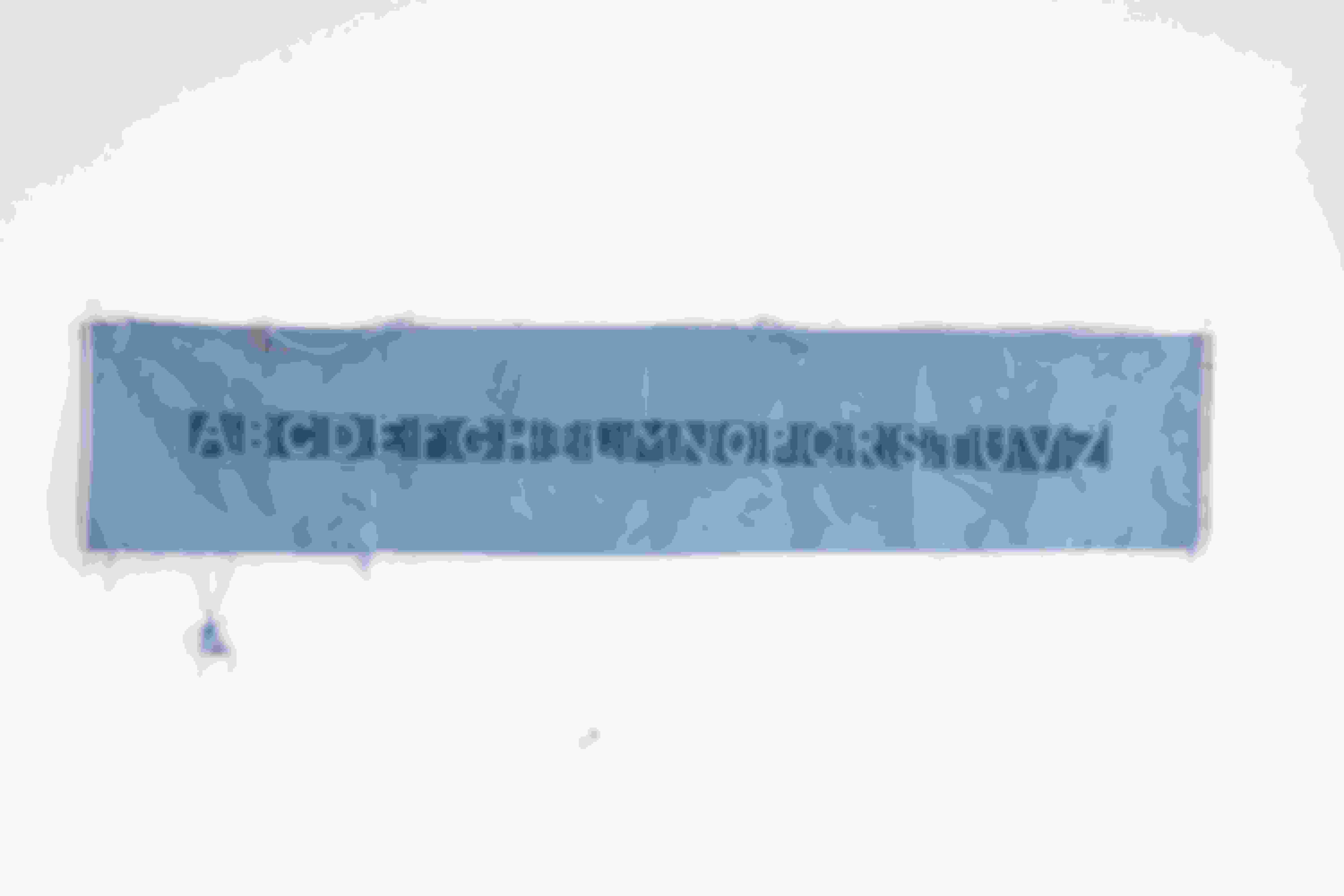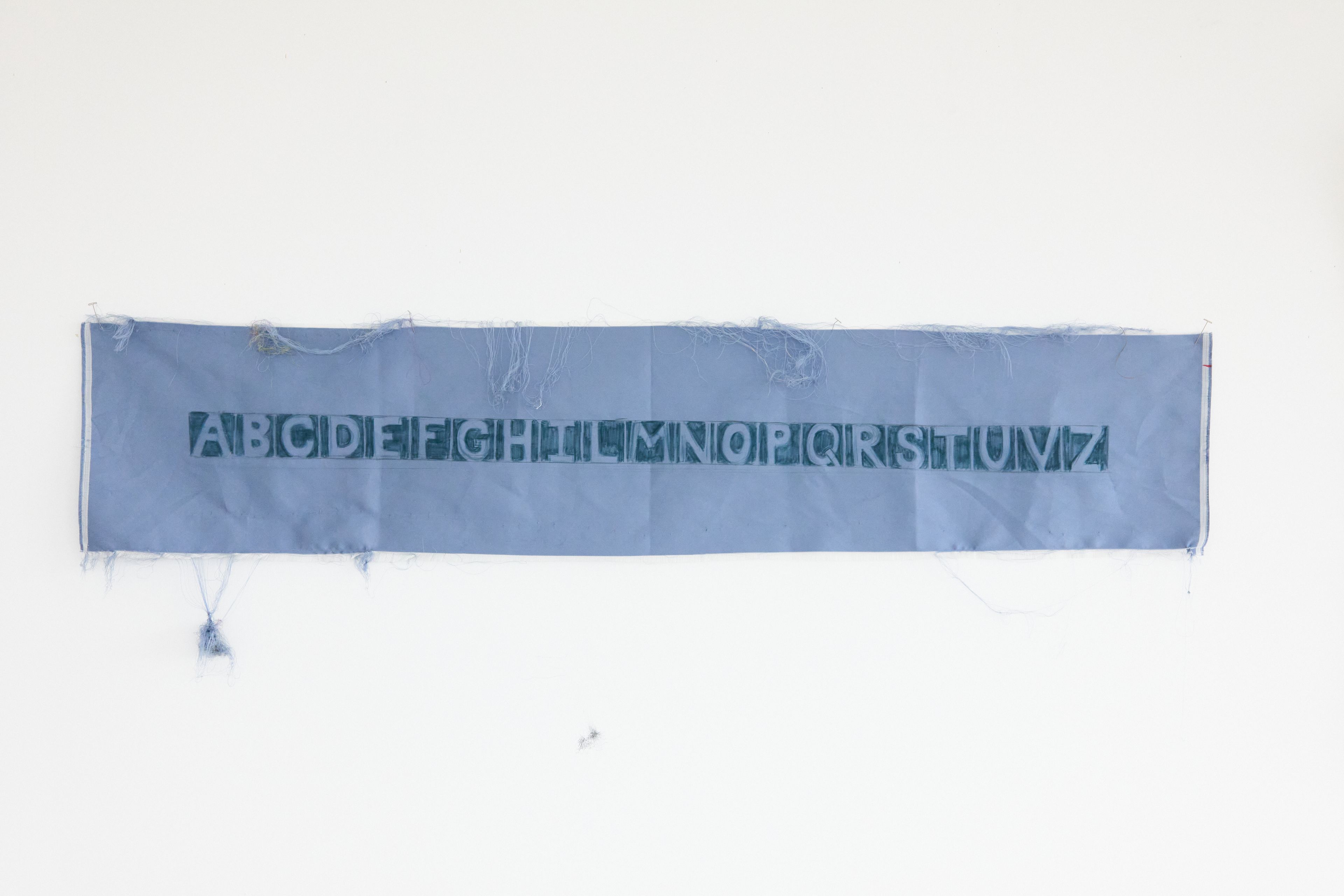This project explores the power of language and of how language belongs to people in power.
- TitleAlpha
- Type(s)Drawing, Performance, Tapestry, Painting
- AgendaEducation
- Year(s)2020–2022
- LocationVeneto, Italy & Paris, France
- ReferencesMarshall McLuhan, Alighiero Boetti
For all its ambitions for futurity, Italy is a country with a long memory and a heritage that has developed over millennia. Foremost among its cultural artifacts is the Roman—or Latin—alphabet. Developed from Etruscan script circa 600 BCE, the Roman alphabet has been in constant use since that time and is now the most widely used writing system in the world.


In their 1977 essay “Alphabet, Mother of Invention,” media theorists Marshall McLuhan and Robert K. Logan argue that the form and structure of written language fundamentally shape a culture’s intellectual possibilities. Their text draws on the 1929 writing of Edward Sapir, subsequently developed by Benjamin Lee Whorf—and more commonly known as the “Sapir-Whorf hypothesis”—which suggests that an individual’s perception and understanding of their world is encoded through and influenced by linguistic structures. While the Sapir-Whorf hypothesis generally focuses upon spoken language, McLuhan and Logan’s turn towards written text emphasized materiality and image.
In charting the history of the Western writing systems, they propose that letters are the origins of symbolic thinking, conceptual abstraction, and visual culture. Implicit in this suggestion is the idea that the leap from spoken language to text is akin to the jump from seeing to creating artistic representations. (In fact, as McLuhan and Logan write, )
Retraining My Left-Hand
As a child I was ambidextrous and when asked what hand I should use because I was able to use both, i was told that I most definitely have to use my right hand as the world was designed for right-handed people. "Think of a pair of scissors, or a hockey stick" -- I was told. I followed the advice and stopped using my left hand.
Being left-handed has historically been associated with negative connotations, superstitions, and cultural biases in various societies. While it's important to note that views on left-handedness have evolved over time, understanding why being left-handed was viewed as a "sin" requires exploring several historical, cultural, and religious factors:
1. Religious and Cultural Beliefs
In many ancient cultures, including some early Judeo-Christian traditions, the right hand was considered more pure, virtuous, and favored, while the left hand was associated with impurity, weakness, and evil. This belief is reflected in religious texts and cultural practices where the right hand was used for sacred rituals, greetings, and gestures of respect, while the left hand was often seen as inferior or taboo.
2. Symbolism and Superstitions
The symbolism associated with right and left hands extended beyond religious beliefs. In various cultures, the right hand symbolized strength, righteousness, and authority, while the left hand symbolized deception, clumsiness, or bad luck. Superstitions and myths surrounding left-handedness contributed to negative stereotypes and biases against left-handed individuals.
3. Historical Persecution
Historically, left-handedness was sometimes viewed as abnormal or unnatural, leading to discrimination and even persecution in some societies. Left-handed individuals were sometimes forced to use their right hand, punished for using their left hand, or stigmatized as being different or deviant.
4. Language and Etymology
The negative connotations associated with left-handedness are reflected in language and etymology. For example, the word "sinister" in English originally meant "left" or "left-handed" but later acquired meanings related to evil or malevolence. Similarly, in Latin, "sinistra" meant left, and "dexter" meant right, with "dexter" also having positive connotations of skill and dexterity.
Evolution of Views
Over time, societal attitudes toward left-handedness have shifted, and many of the negative stereotypes and biases have diminished. In modern times, being left-handed is generally accepted and recognized as a natural variation in human physiology rather than a sin or defect. However, remnants of historical biases may still linger in certain cultural contexts or linguistic expressions.
It's important to promote inclusivity, respect diversity, and challenge outdated beliefs or prejudices regarding left-handedness or any other natural human trait. Embracing individual differences and celebrating diversity enriches our understanding of human identity and contributes to a more inclusive and tolerant society.
Can I have a Brink of Water?, performance
The letters of the Roman alphabet signify sounds, themselves fragments of an entire utterance that composes a word. The relationship, however, between these characters and their spoken interpretation is not one-to-one. Though the alphabet contains 26 letters, the English language contains 44 phonemes, or sounds that distinguish words from each other.
As a child, I had a speech impediment which involved confusing Bs and Ds. Recalling this now, it strikes me as no surprise that this vocal conflation was tied to a visual one, the letters ‘d’ & ‘b’ like a single shape swinging aimlessly around the same vertical stroke. In treatment for my childhood Apraxia—attempts to train my unruly tongue—the doctor and I would sit in adjoining rooms, speaking to each other through a glass barrier, our faces like two spheres separated by a vertical surface. As if distant in time or space, her voice would come to me through headphones, while my voice was transmitted to her through a microphone.
Several works in Alpha make use of these verbal-textual confusions. Can I have a brink of water? explicitly refers to my confusion of the letters D and B. In this performance, I read poetry which emphasizes the letters B and D to perform some of these verbal confusions and reenact exercises that I performed as a child during speech therapy.
A new poem inspired by where the letters "b" and "d" are intentionally confused to create a sense of playfulness and absurdity:
"Dabble Dabble, Drombe Dants"
Dabble dable, drombe dants, Dilly-dally, daze in dazes. Bewilderment bounds, dreaking breeze, Distant drumbeats, dumble dazes.
Dabble dable, dribble drapes, Dive in dilly-dally daces. Blurred botes, dashing breeze, Dizzily draping, dumble daces.
Dazzled by dakeless dreams, Daringly dabble in dungle schemes. Bumbling bards, dashing in daces, Drenched in dappled daseless dreams.
Dazzling drops of dew on dreen leaves, Bancing brooks, babbling beside dales. Dancing droplets, dashing in the dusk, Drizzling down, dappling daisy fields.
Bubbles bloom, burst in the breeze, Diving ducks, dipping down in dreams. Bubbling brooks, babbling in delight, Dancing droplets, dazzling in the light.
Drifting downstream, drenched in delight, Diving dolphins, darting in the deep. Bubbling springs, bubbling in the blue, Dreaming of the dawning day anew.


Can I have a brink of water? video.
Dadaism and Its Essence
Dadaism was not just an artistic movement but a revolutionary cultural and intellectual rebellion against the prevailing social order and the devastation of war. Dadaists rejected logic, reason, and conventional forms of art, embracing chance, spontaneity, and absurdity as tools of creative expression.
Central to Dadaism was the belief that traditional art forms had lost their relevance in a world marked by violence, political upheaval, and disillusionment. Dadaists used collage, readymades, performance art, and unconventional poetry like Ball's "Karawane" to subvert expectations, challenge authority, and provoke thought.
Message Massage Mess Age Mass Age
Another work alludes to Marshall McLuhan and graphic designer Quentin Fiore’s 1967 book The Medium is the Massage. The book’s title was intended to directly quote McLuhan’s iconic phrase “the medium is the message.” However, due to a typesetter’s error, the original proof replaced “message” with “massage.” Delighted by the mistake and all of the alternate readings it invited—including, “mess age” and “mass age”—McLuhan insisted that the book be published under the alternate title.
Resequenced Hierarchy
I spent several years of my childhood selectively mute—a decision that literalized the invisibility I felt after the birth of my parent’s first male child. The years that I spent without speaking revealed to me the power of language and, conversely, how language belongs to people in power. The Roman alphabet has come to such prevalent use by way of colonial power—and many other scripts, languages, and modes of communication have been displaced or entirely forgotten as a result. For many, respectful communication is not a given even in the domestic sphere. Patriarchy still dominates in many parts of the world, including Italy, where many families are controlled by a male leader—or an “alpha,” if you will. While speech can be used as a method of equitable discourse and mutual understanding, it can also be harnessed as a tool for manipulation and control. Given this relationship, I am interested in the way that the alphabet has also been used to denote social hierarchies—for example, alpha, beta, delta, and gamma. Like the ranking system that it represents, the sequence of these letters is arbitrary—unlike a numeric system, alphabetic characters do not have intrinsic value and a concomitant order. This very fact begs the question of when the system can change. How can the order be reshuffled? This series attempts to realize this resequencing of these hierarchies through an installation of body-scale letters—Α, Β, Γ, Δ—which have been purposefully placed out of order. The mirrored surface of these characters suggests the fact that, now free of my family’s sphere of influence, I am my own leader, with the power to recreate what being an “alpha” means to me.
Another way in which I am trying to contribute to this edit is through an edition of tapestries featuring the Italian alphabet—which doesn’t include the letter J, the first letter of my name, nor K, W, X, or Y. This work is also influenced by the textiles of Arte Povera artist Alighiero Boetti, who hired Afghani and Pakistani artisans to choose the colors for and stitch dense, gridded tapestries that spelled out words or sayings in Italian.
Like Boetti, the future fabrications of this work will be with a local Italian organization based outside of Milano that trains youth who suffer from anxiety, depression, or instability at home in artisanal trades. The series is stitched into discarded silk, with blue for the ground and magenta for the characters, a choice of color which interrogates gender stereotypes.
Je
With a relocation to France issued the recognition to the importance of the letter 'J'. This is a series of small paintings the word 'Je' as it refers to 'I'. In the French language, "je" is a very important word as it means "I" in English. It is a subject pronoun used to refer to oneself, equivalent to the first-person singular pronoun "I" in English. Here are a few examples of how "je" is used in sentences:
- Je suis heureux. (I am happy.)
- Je parle français. (I speak French.)
- Je vais au cinéma. (I am going to the cinema.)
- Je mange une pomme. (I am eating an apple.)
- Je t'aime. (I love you.)
"Je" is a fundamental word in French grammar and is used to express actions, feelings, states of being, and much more, serving as the starting point for constructing sentences in the first person singular form.
In part, this series joins a tradition of artists challenging the totalitarianism of the Roman script. Argentine artist Leandro Katz, for example, has done several works surrounding the Spanish-language letter Ñ.
French Alphabet
The French alphabet is also based on the Latin alphabet but includes several diacritics and additional letters compared to the English alphabet. The French alphabet consists of 26 letters, including the letter "J."
Here is the complete French alphabet: A, B, C, D, E, F, G, H, I, J, K, L, M, N, O, P, Q, R, S, T, U, V, W, X, Y, Z
In French, the letter "J" is pronounced as /ʒ/, representing a voiced postalveolar fricative sound.